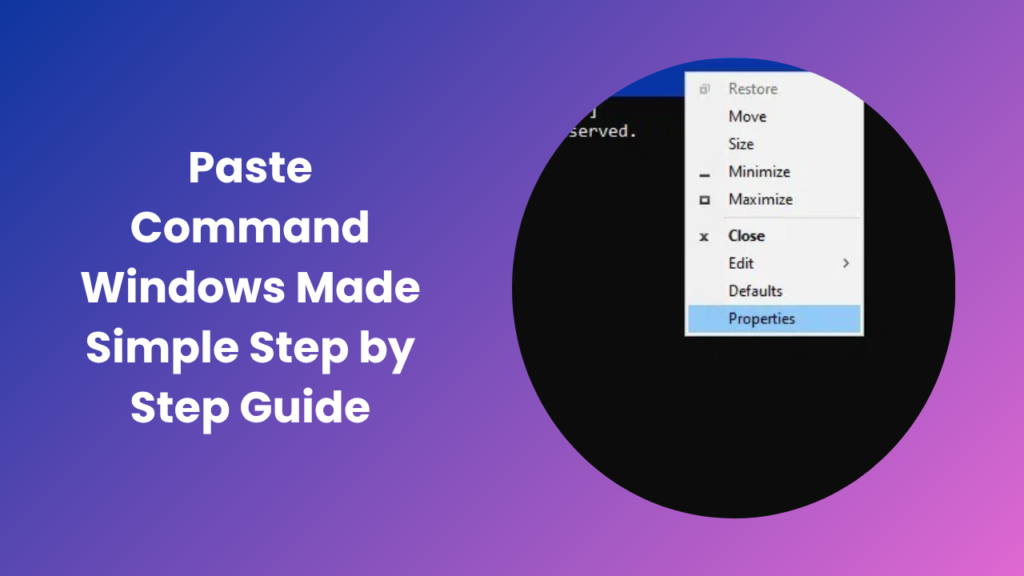The Windows Command Prompt is one of the most powerful tools available for interacting directly with the operating system. Although it may appear simple, CMD allows for precise execution of commands, efficient script management, and automation of complex tasks that would otherwise take multiple steps in graphical interfaces. Among its many functionalities, mastering the paste command Windows can save a significant amount of time and improve workflow efficiency. Copying and pasting in CMD is different from typical software because the terminal interprets every character precisely, and even a small error can prevent commands from executing. This guide will explore how to paste commands effectively, troubleshoot common problems, and apply best practices for a more seamless experience in the Command Prompt.
Understanding the Basics of the Command Prompt
The Command Prompt, also called CMD, is a text-based interface designed to allow users to communicate with Windows directly through typed commands. Unlike modern software with graphical interfaces, CMD processes input line by line, and the system interprets each command exactly as it is typed or pasted. This precision makes pasting commands slightly more challenging because any extra spaces, hidden characters, or formatting errors can result in failed execution. Understanding this environment is critical, as it allows users to anticipate how the terminal will handle pasted commands. CMD is ideal for advanced operations, automation, and troubleshooting because it gives control over almost every aspect of the system. Users who become comfortable with CMD often find that they can perform tasks faster and more accurately than with traditional GUI-based methods.
Different Methods to Use the Paste Command in Windows
There are several reliable ways to use the paste command Windows in CMD, each with its advantages depending on user preference, operating system version, and type of command. Knowing multiple methods allows for flexibility and ensures commands are executed without errors. Selecting the right method can save time, improve efficiency, and minimize frustration when working with long scripts or repetitive tasks. Learning these techniques also builds confidence in using the Command Prompt for complex operations.
Using Keyboard Shortcuts
Keyboard shortcuts are often the fastest way to paste commands in CMD. On modern Windows systems, pressing Ctrl + V allows you to paste copied text directly into the terminal. Older versions of Windows, however, may require enabling certain settings for shortcuts to work properly. Mastering keyboard shortcuts is especially useful for users who frequently work with scripts or need to execute multiple commands quickly. By reducing reliance on the mouse, shortcuts save time and allow users to maintain a smooth workflow. In addition, understanding how shortcuts function helps prevent errors caused by accidental extra keystrokes or misalignment when entering commands manually.
Enabling QuickEdit Mode
QuickEdit Mode is a feature that simplifies copying and pasting in CMD by allowing users to select text with the mouse and paste it using a right-click. To enable QuickEdit Mode, right-click the CMD title bar, go to Properties, and check the QuickEdit Mode option. This small configuration change significantly improves efficiency, particularly when working with long commands or multiple lines of code. QuickEdit Mode also provides an intuitive way to highlight text for copying or editing without leaving the terminal. For users who rely on both keyboard and mouse input, this feature reduces the likelihood of errors and makes the overall experience smoother and more productive.
Using the Context Menu
The right-click context menu offers another reliable method for pasting text into CMD. By right-clicking anywhere inside the terminal window, users can access options such as Paste, Select All, and Mark. While using the mouse may be slightly slower than keyboard shortcuts, this method ensures that text is inserted accurately without being affected by hidden formatting characters. The context menu is particularly useful when copying commands from web pages, documents, or scripts that might include extra spaces or unusual characters. It provides a straightforward alternative for users who are less comfortable with shortcuts or who encounter shortcut failures due to system settings.
Pasting in Windows PowerShell
Windows PowerShell is a more advanced command-line interface that also supports pasting commands, often more effectively than CMD. PowerShell allows users to paste multiline commands reliably and provides syntax highlighting, which makes it easier to detect errors before executing commands. Transitioning from CMD to PowerShell can be advantageous for those dealing with complex scripts or administrative tasks. The enhanced clipboard handling and better formatting support reduce common issues that occur in CMD. PowerShell also offers improved automation capabilities, making it an ideal environment for users who need to perform advanced system operations with fewer errors.
Common Issues and Troubleshooting
Even experienced users encounter challenges when pasting commands into CMD, and knowing these common issues can save time and frustration. Being aware of potential problems allows users to take proactive measures, such as cleaning formatting or adjusting settings, to ensure commands execute correctly. Troubleshooting is also an opportunity to better understand CMD’s behavior and improve overall command-line proficiency.
Formatting Problems
One of the most frequent issues occurs due to formatting errors. Text copied from web pages, documents, or rich text editors may contain hidden characters, extra spaces, or unsupported symbols. These subtle differences can prevent commands from executing or produce unexpected results. A practical solution is to paste the command first into a plain text editor like Notepad to remove unwanted formatting before transferring it to CMD. This extra step ensures that the command is clean and ready for execution. It is especially important when working with scripts that include multiple lines or special characters. Understanding formatting problems and addressing them proactively can save time and prevent repeated errors.
Shortcut Failures
Keyboard shortcuts sometimes fail because of system settings or CMD configuration. If Ctrl + V does not work, enabling QuickEdit Mode or running CMD as an administrator may resolve the issue. Occasionally, restarting CMD or the computer is necessary, especially after system updates or software installations that affect clipboard behavior. Knowing alternative methods such as right-click pasting or using QuickEdit Mode ensures that users can continue working efficiently without interruptions. Being familiar with these solutions also builds confidence in navigating CMD under different circumstances and troubleshooting unexpected behavior.
Clipboard Conflicts
Other programs running on your computer can interfere with clipboard operations, preventing successful pasting. Clipboard managers, remote desktop applications, or certain browser extensions may disrupt CMD’s ability to accept pasted commands. Closing unnecessary programs or using the right-click context menu can bypass these conflicts and ensure commands are inserted correctly. In situations where frequent pasting is necessary, temporarily disabling conflicting applications can improve reliability and reduce the chance of errors. Awareness of potential clipboard conflicts helps maintain smooth workflow, particularly for users who work with multiple software tools simultaneously.
Best Practices for Using Paste Command Efficiently
To maximize productivity, users should adopt best practices for pasting commands in CMD. Always verify commands for accuracy before pasting, particularly when copying from external sources. Understanding the purpose of each command prevents unintended system changes and strengthens command-line knowledge. Avoid pasting long scripts without checking the structure, as CMD processes commands line by line. Learning CMD shortcuts, utilizing QuickEdit Mode, and familiarizing oneself with the context menu can improve efficiency and reduce repetitive tasks. Consistency and attention to detail are key to mastering CMD operations and ensuring reliable command execution.
Automation and Scripting
Advanced users can combine pasting with batch files or PowerShell scripts for automation. Preparing commands in a text editor and pasting them into CMD allows for consistent execution and reduces human error. Automation is particularly useful for system administrators, developers, or users handling repetitive tasks. By leveraging scripting capabilities, commands can be executed automatically, saving time and ensuring accuracy. This approach also minimizes risks associated with manual input errors and allows users to manage complex operations with confidence.
Maintaining Security
Pasting commands carries inherent security risks. Only copy commands from trusted sources and review their content before executing them. Malicious or poorly written commands can compromise system security or data integrity. Understanding each command’s function helps prevent accidental damage and promotes safe practices. Users should develop the habit of verifying and testing commands, even when sourced from reputable websites, to maintain a secure command-line environment. Awareness of potential risks ensures that users can confidently leverage CMD’s full capabilities without compromising system safety.
FAQs
How do I paste text into Command Prompt if keyboard shortcuts fail?
Enable QuickEdit Mode or use the right-click context menu to paste commands. These methods provide reliable alternatives when keyboard shortcuts are unavailable.
Can I paste multiple lines of commands at once?
Yes, but CMD executes each line sequentially. Ensure that each line is complete and properly formatted to avoid errors.
Why does my pasted command sometimes fail?
Extra spaces, hidden characters, or formatting issues often cause failures. Pasting into a plain text editor first usually resolves these problems.
Is there a difference between CMD and PowerShell pasting?
PowerShell supports multiline commands and syntax highlighting, making it better for complex scripts and advanced operations.
Can I automate pasting commands for repetitive tasks?
Yes, using batch files or PowerShell scripts allows commands to run automatically, saving time and minimizing errors in repetitive workflows.
Conclusion
Mastering the paste command in Windows CMD is a small but powerful skill that can significantly improve your productivity and make working in the Command Prompt much smoother. By following the simple steps outlined in this guide, you can quickly insert copied commands without mistakes, avoid repetitive typing, and streamline your workflow. The tips and shortcuts shared here are designed for users of all experience levels, from beginners to advanced CMD users, ensuring that everyone can benefit. Practicing these methods regularly will make the paste command second nature, allowing you to work more efficiently and confidently. With these skills in hand, handling commands in Windows CMD becomes faster, easier, and much more manageable. Learning the paste command Windows thoroughly equips you to execute commands with precision, save valuable time, and tackle tasks more effectively in any Windows environment.





